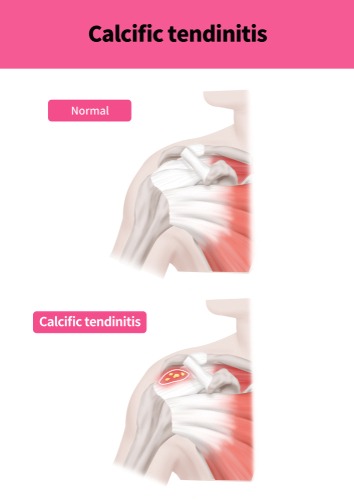Calcific Tendinitis of The Shoulder Treatment
 Calcific tendinitis of the shoulder refers to a condition in which the shoulder tendons or the rotator cuff becomes inflamed. Calcium deposits may start to build up, causing bonelike structures. Calcific tendinitis of the shoulder usually occurs in the age group 40 to 60. It is caused because of shoulder overuse. However, there are surgical and non-surgical treatment options to help you resume normal motion and your daily routine.
Calcific tendinitis of the shoulder refers to a condition in which the shoulder tendons or the rotator cuff becomes inflamed. Calcium deposits may start to build up, causing bonelike structures. Calcific tendinitis of the shoulder usually occurs in the age group 40 to 60. It is caused because of shoulder overuse. However, there are surgical and non-surgical treatment options to help you resume normal motion and your daily routine.
Thomas & Bigler Knee and Shoulder Institute, led by board certified orthopedic surgeons Dr. Steven C. Thomas and Dr. Gregory T. Bigler, provides orthopedic surgery to patients in Las Vegas, Nevada, while also serving areas such as greater Pahrump, Bullhead City, Lake Havasu, and Mesquite, NV.
Understanding Calcific Tendinitis of The Shoulder
Calcium deposits can build into dense, bonelike structures in your shoulder tendons and muscles. This area is also called rotator cuff. Calcific tendinitis of the shoulder is a common cause of shoulder pain. Heavy lifting, tennis, and basketball among other overhead motions may cause this condition. Other causes of calcific tendinitis of the shoulder include:
- Abnormal cell growth
- Abnormal thyroid gland activity
- Genetic predisposition
- Production of anti-inflammatory agents in the body
- Diabetes and other metabolic diseases
Women are generally more likely to be affected by this condition as compared to men.
Symptoms of Calcific Tendinitis of The Shoulder
These are a few symptoms of the condition:
- Minor pain while at rest or performing any activity
- Radiating pain from the side of the arm to the front of the shoulder
- Sudden pain during reaching movements or while lifting
- Athletes may develop pain while throwing
Symptoms may worsen into the following with time:
- Pain during night
- Loss of motion and strength
- Difficulty buttoning, zippering and other activities
Diagnosing Calcific Tendinitis of The Shoulder
Your orthopedic surgeon will look at your overall health, medical history, and symptoms during the physical examination. They may recommend certain tests to check calcium deposits. They will also make sure the symptoms are not because of another injury.
Calcific tendinitis of the shoulder is generally confirmed by x-rays. This is because dense calcium deposits can be easily seen in an x-ray. Ultrasound is another useful test to look for smaller calcium deposits the x-ray may have missed.
Understanding the Treatment
You can choose between surgical and non-surgical treatment options to get back to your routine. Non-surgical options are usually recommended since they are non-invasive in nature. Your physician may consider surgical avenues if the non-surgical options fail.
Typically, surgical procedures involve creating more space arthroscopically. This allows the rotator cuff to sit well. Your surgeon may remove the bursa completely or just the inflamed part to get this done. Correlating with this, the surgeon may also address any other condition causing pain that is present in the shoulder while performing this surgery.
This can be in the form of arthritis or biceps tendonitis (inflammation of the biceps tendon). Arthritis is usually in between the acromion and the collarbone (acromioclavicular arthritis). The surgeon may also repair partial rotator cuff tear, if any.
Orthopedic surgeons Dr. Thomas and Dr. Bigler receive patients from Las Vegas, Nevada as well as greater Pahrump, Bullhead City, Lake Havasu, and Mesquite, NV for orthopedic surgery.
Contact Board Certified Surgeons Dr. Bigler or Dr. Thomas at the Knee and Shoulder Institute in Las Vegas, NV to Schedule an Appointment:
If you would like to schedule an appointment or learn more about the Knee and Shoulder Institute procedures & treatments performed by Las Vegas, Nevada board-certified surgeons Steven C. Thomas, MD and Gregory T. Bigler, MD. Contact the office today click here.
Serving patients from and around greater Las Vegas, Lake Havasu, Bullhead City, Mesquite, Pahrump, Nevada
